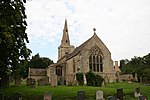Boughton House is a country house in the parish of Weekley in Northamptonshire, England, situated about 3 miles (4.8 km) north-east of Kettering. It is situated within an estate of 11,000 acres (4,451.5 ha).
The present house was built by Ralph Montagu, 1st Duke of Montagu (d.1709), immediately after 1683 when he inherited the estate from his father, whose own grandfather Sir Edward Montagu, Lord Chief Justice, had bought it in 1528.
The 1st Duke had served as the Ambassador to France during the 1670s and was much influenced by contemporary French architecture and garden design, especially by the Palace of Versailles, which style he reproduced at Boughton.It is now one of the seats of the builder's descendant Richard Montagu Douglas Scott, 10th Duke of Buccleuch and is famed for its beauty, its collections, and for having survived virtually unchanged since the 17th century. While possessing a medieval core, its exterior evokes a 17th century French chateau, causing it to be termed The English Versailles (a moniker also applied to Petworth House in Sussex, amongst others).
The magnificence of the collections at Boughton is explained by the ducal family surname Montagu-Douglas-Scott, which reflects the union of three great families and their estates through marriage: Montagu, the Dukes of Montagu; Douglas, the Dukes of Queensberry; and Scott, the Dukes of Buccleuch.
Boughton contains a comprehensive collection of furniture, tapestries, porcelain and carpets. The art collection includes many notable paintings such as The Adoration of the Shepherds by El Greco, Thomas Gainsborough’s portrait of Mary Montagu, and a celebrated series of grisailles by Van Dyck, and Breaking Cover by John Wootton.
Once a servants' hall, located next to the kitchen, the armoury is now home to what many experts regard as one of the finest privately held armouries in the country. It is an historic collection that owes much to John, 2nd Duke of Montagu (1690–1749).
Boughton House is a venue for events, weddings, corporate activities and organised groups. The House opens on specific dates for guided tours.










